Author: anonymous | Editor: Jan Herca
Dear,
For more than two years I have been intrigued by the article “A Council of Giants” (2014)[1]. The reason for my perplexion is that this work seems to recognize in part (with the exception of the galaxy UGCA 320) a structure similar to the one described in papers from 1955. We know that at that time there was not enough scientific information for one to suppose the existence of the Local Sheet, or the Council of Giants, with the way such galaxies are arranged. I listed briefly 10 items that I think are at least unlikely to have been proposed or simply “predicted” during the 1950s. I wrote in a simple and explanatory way with the intention to provide the contents of that letter in full to friends and those interested.
The papers to which I refer, are known as The Urantia Book[2], initially written between 1934-1935, and published in 1955. The papers mention the existence of a structure of galaxies in a large ellipse disposed in a plane, and “below” and “above” this structure there is, on each side, one huge void. The text also provides the seven relative positions of the main galaxies. Due to the time of the composition of this work, several terms used by the author(s) to express a concept or things were magnified or new expressions were created as the scientific definitions of the 30s were exhausted or when the author(s) understand that they should use their own expressions. The following are some examples:
| Expressions used in The Urantia Book (1955) | Equivalent or usual terms |
|---|---|
| Superuniverses | Galaxies and satellite galaxies |
| Grand Universe | Council of Giants [?] |
| Outer Space Levels | Group of superclusters and filaments |
| Space Respiration (expansion phase) | Expansion of Space |
| Master Universe | Whole Universe |
| Midspace Zones of Quiescence | Cosmic Voids |
| Nebulae | Galaxies, planetary nebulae |
| Universes (in the spacetime) | Galaxies, galaxy fractions, whole universe |
| Local Universes | Galaxy fractions |
List of approximate expressions
¶ A Council of Giants
The Local Void occupies a “superior” position in relation to supergalactic plane, but the Urantia papers adopt the supergalactic north pole like the southern of “master universe” (fig. 2). Therefore, the representation of Council of Giants, looking from the top, would be in the inverted position of which is presented in the 2014 article (see [Figure 1]).
Remembering that the giant galaxies and its satellite galaxies are also called Superuniverses[3] by The Urantia Book, the same informs their positions in the large ellipse since 1935. According to the book, there are 7 major galaxies that are inhabited, and the Milky Way is one of them. The central point of this ellipse is called the Great Sources and Centers, Havona, the Eternal Isle or Paradise[4].
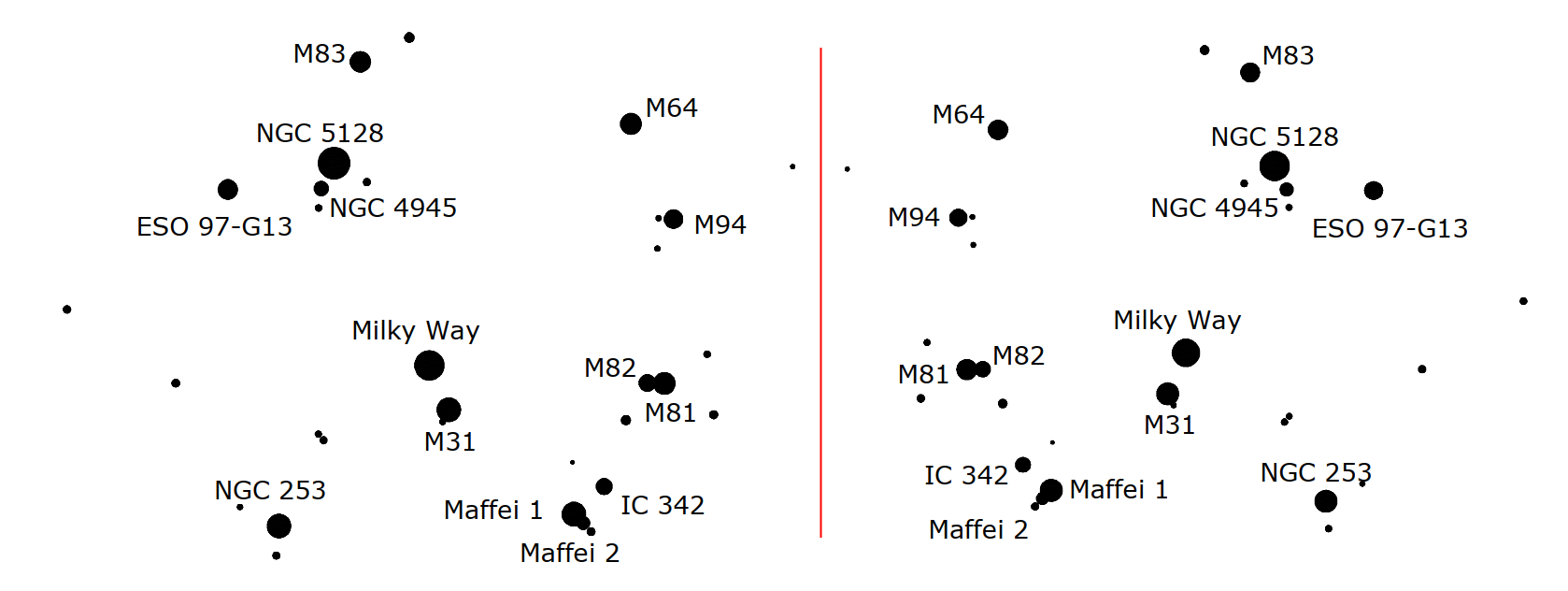
We have long since discovered that the seven superuniverses traverse a great ellipse, a gigantic and elongated circle. UB 15:1.2
In this age and as direction is regarded on Urantia, superuniverse number one swings almost due north, approximately opposite, in an easterly direction, to the Paradise residence of the Great Sources and Centers and the central universe of Havona. This position, with the corresponding one to the west, represents the nearest physical approach of the spheres of time to the eternal Isle. Superuniverse number two is in the north, preparing for the westward swing, while number three now holds the northernmost segment of the great space path, having already turned into the bend leading to the southerly plunge. Number four is on the comparatively straightaway southerly flight, the advance regions now approaching opposition to the Great Centers. Number five has about left its position opposite the Center of Centers while continuing on the direct southerly course just preceding the eastward swing; number six occupies most of the southern curve, the segment from which your superuniverse has nearly passed.
Your local universe of Nebadon belongs to Orvonton, the seventh superuniverse, which swings on between superuniverses one and six, having not long since (as we reckon time) turned the southeastern bend of the superuniverse space level. Today, the solar system to which Urantia belongs is a few billion years past the swing around the southern curvature so that you are just now advancing beyond the southeastern bend and are moving swiftly through the long and comparatively straightaway northern path. For untold ages Orvonton will pursue this almost direct northerly course. UB 15:1.4-5
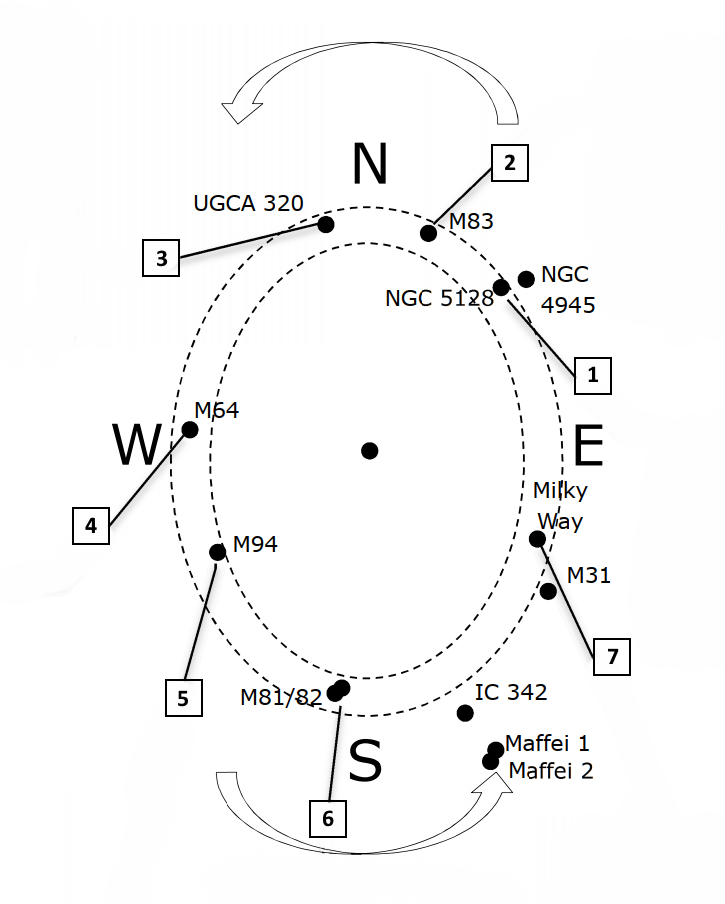
Although the Andromeda galaxy (M31) is part of the Council of Giants, it is not considered by the Urantia Papers as one of the 7 inhabited galaxies:
. . . There are not many sun-forming nebulae active in Orvonton at the present time, though Andromeda, which is outside the inhabited superuniverse, is very active. . . . UB 15:4.7
Still, it seems that in the future it will become part of the “seventh superuniverse,” to merge with the Milky Way.
Naturally, some may say that the recognition of an “ellipse” inside the Council of Giants is not visually apparent. By the way, seven large galaxies (Circinus, NGC 253, Maffei 1, Maffei 2, IC 342, M31 and NGC 4945) were left out of the ellipse. However, the authors[5] of the Urantia Papers certainly knew of this “disorder” around the great ellipse when they spoke about the group of these galaxies (grand universe) in 1934:
. . . The present ragged edge of the grand universe, its uneven and unfinished periphery, together with the tremendously unsettled condition of the whole astronomical plot, suggests to our star students that even the seven superuniverses are, as yet, uncompleted. . . . UB 12:1.13
. . . The seven superuniverses are still growing; the periphery of each is gradually expanding; new nebulae are constantly being stabilized and organized; and some of the nebulae which Urantian astronomers regard as extragalactic are actually on the fringe of Orvonton and are traveling along with us. UB 12:2.3
We can see the incredibly precise accuracy of the authors, especially when they describe the position of the third superuniverse (UGCA 320 and its surroundings). Considering that the first catalog register of this galaxy is from 1959 [6], four years after the publication of The Urantia Book. Although UGCA 320 is not part of the Council of Giants, it is in the exact position mentioned by The Urantia Book with other nearby small galaxies. The distance of this galaxy has been updated in the new 2013 compilation (Cosmicflows-2)[7], that classified it with a distance of 5.42 ± 0.20 Mpc.
The prior and inexplicable knowledge of the authors in describing the ellipse of galaxies is so great that if there was only one galaxy with the wrong coordinates and distances then the whole narrative set would be compromised. For example, if we removed any of the set of galaxies (NGC 5128, M83, UGCA 320, M64, M94, M81/M82 or the Milky Way) then we could hardly see the course of the elipse. Even if we wanted to forcibly search for an elliptical arrangement of galaxies with such properties and positions (including the Milky Way), even tens of Mpc away or more, we would not find.
¶ Stars independent travelers
Another bold claims from the authors is related to the independent trajectories of the Milky Way suns. Describing the process of suns formation by an ex nebula of the Milky Way (named as Andronover) they say:
. . . this was only a temporary stage of nebular progression. The ever-increasing rate of whirling was soon to throw enormous suns off into space on independent circuits. UB 57:3.4
. . . the first Andronover sun . . . blazing streak broke away from the mother gravity grasp and tore out into space on an independent adventure in the cosmos of creation. Its orbit was determined by its path of escape. Such young suns quickly become spherical and start out on their long and eventful careers as the stars of space. Excepting terminal nebular nucleuses, the vast majority of Orvonton suns have had an analogous birth. These escaping suns pass through varied periods of evolution and subsequent universe service. UB 57:3.6
Only in 2015, sixty years after the publication of The Urantia Book and about eighty years since its writing, researchers from New Mexico State University found that many of the stars of the Milky Way have drastically changed their orbits over time. The lead author of the new study, Michael Hayden, said:
In our modern world, many people move far away from their birthplaces, sometimes halfway around the world. Now we’re finding the same is true of stars in our galaxy — about 30 percent of the stars in our Galaxy have traveled a long way from the orbits in which they were born.[8]
¶ Cosmic Voids
The midspace zones of quiescence (basically the cosmic voids[9]) are enormous and practically empty and quiet regions that clearly define the Local Sheet[10]. The existence of so-called Local Void was only discovered in 1987, 32 years after the publication of The Urantia Book. This region is so empty that it was completely unexpected by the standard cosmology. Early studies of the cosmic voids began in the 70s, and the first were discovered only in 1978. Notwithstanding the fact that Gerard de Vaucouleurs having made a brief reference to these empty regions in 1975 (see below) in the article Nearby Groups Of Galaxies[11]. At time of writing (1934-1935) and even in the year of publication of the Urantia Papers, the scientific community still had no idea about the existence of these empty regions and relatively calm space.
The relatively quiet zones between the space levels, such as the one separating the seven superuniverses from the first outer space level, are enormous elliptical regions of quiescent space activities. These zones separate the vast galaxies which race around Paradise in orderly procession. You may visualize the first outer space level, where untold universes[12] are now in process of formation, as a vast procession of galaxies swinging around Paradise, bounded above and below by the midspace zones of quiescence and bounded on the inner and outer margins by relatively quiet space zones.
A space level thus functions as an elliptical region of motion surrounded on all sides by relative motionlessness. Such relationships of motion and quiescence constitute a curved space path of lessened resistance to motion which is universally followed by cosmic force and emergent energy as they circle forever around the Isle of Paradise. UB 11:7.7-8
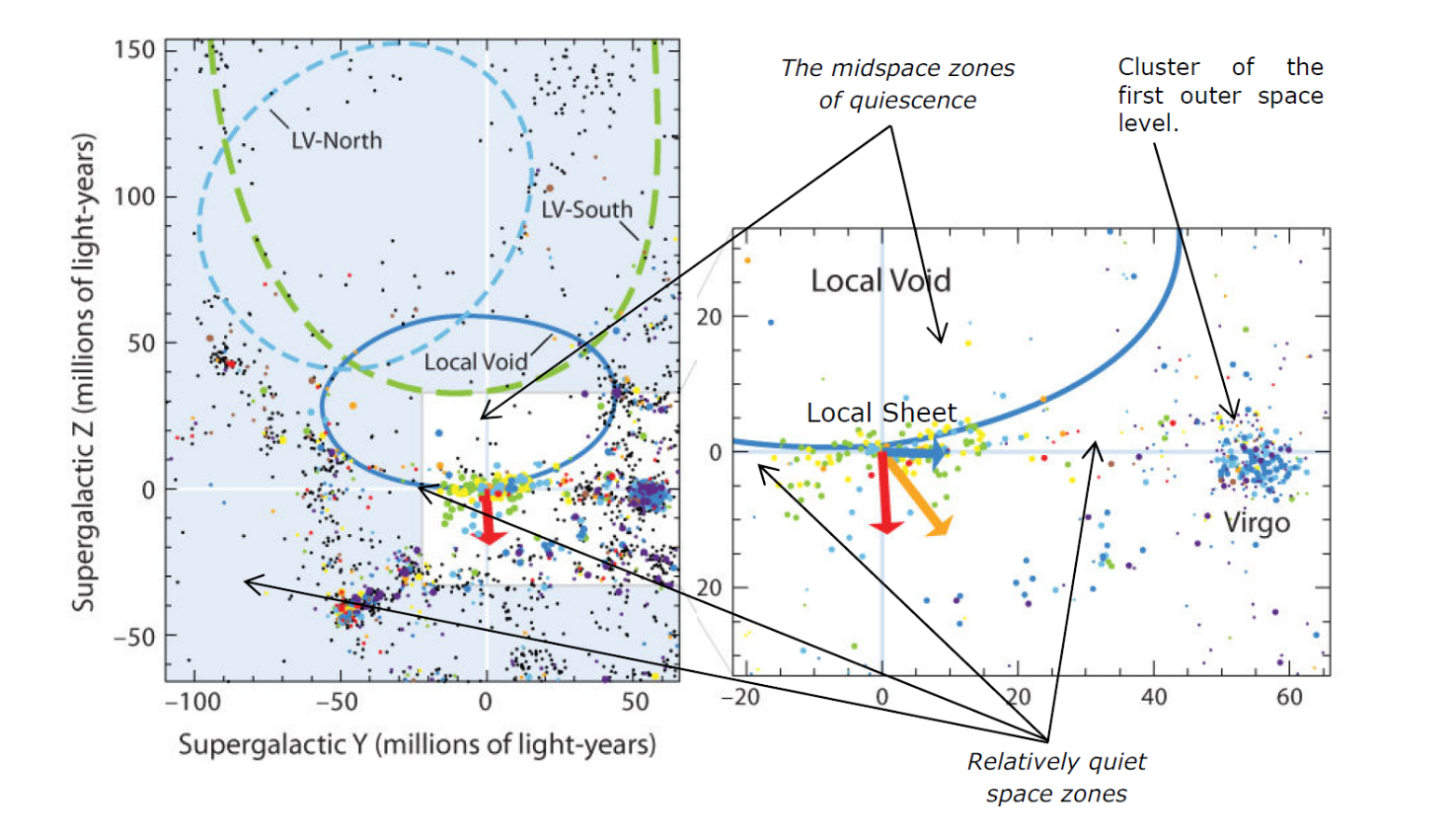
¶ North and South Super Voids
The papers published in 1955 affirm the existence of huge extension space “superior” and “inferior” that are less rich in galaxies, called by them as space reservoirs (unpervaded space). This topic is similar to the previous one, except for the fact that The Urantia Book specifically mentions the existence of these two Super Voids and states that one occupies a lower region, and the other a superior position in relation to what we know as Local Sheet. These voids were designated by Northern Local Supervoid[13] e Southern Local Supervoid[14]

The interesting point is that these voids were discovered only about 25 years after the publication of the Urantia papers[15].
The De Vaucouleurs article mentioned above has indications like these:
The flattened local supersystem is also clearly in evidence when the space distribution of the 55 nearby groups and clouds is mapped as in figures. Figure 8 [shown here] is a projection in the (Y, Z)-plane; and since the center of the supercluster is apparently in the direction of the Virgo cluster (L = 104°), this projection approximates a meridional cross-section. Note the accumulation of groups within 5 Mpc from the supergalactic plane for Y > -5 Mpc. (De Vaucouleurs, G. Nearby groups of galaxies. Galaxies and the Universe 1 (1975): 557.)
Additional Editor’s Note
Several data that are indicated in the De Vaucouleurs article, and that are clearly reflected in the figure, have a complete parallelism with The Urantia Book. In the first place, the marked flattening of all the groups of galaxies that surround the Local Group stands out. It is perfectly observed how there is a preference in this area of the universe for a position close to a plane, in a similar but not identical way as the book predicts. This plane is currently known as the Supergalactic plane, and as can be seen, it is practically at a right angle to the galactic plane. This somewhat contradicts The Urantia Book, which seems to establish that the plane of our galaxy is also the main plane of galaxy accumulation (UB 11:7.6-7), something that has not been discovered to be so.
On the other hand, the article also highlights an accumulation of groups at a distance of 16 million light-years (5 Mpc) which coincides perfectly with the book’s prediction that there is a belt of galaxies 25 million light-years wide. The center of that belt could well be at that distance offered by the article. Finally, the figure itself highlights the area of obscuration of the Milky Way that could easily widen to form a large empty space of V-shaped galaxies at the top and bottom of the supergalactic plane. Note that with a single exception in the south there are hardly any clusters of galaxies in an entire space north and south of this cross section of the nearby universe.
The obscuration zone is a zone that every astronomer knows in which the stellar dust and gas of the Milky Way prevent the correct observation of what lies beyond. It is due to our observation position within the galaxy. It must be recognized that although the diagram shows wide empty spaces to the north and south of the supergalactic plane, the truth is that there are huge clusters of galaxies beyond these voids, further north and south. In this regard The Urantia Book does not clarify what is inside the unpenetrated space. Are there galaxies? Whatever is there must contain something that counterbalances the space penetrated (UB 11:6.3).
Now look what is said by The Urantia Book 20 years before:
The vertical cross section of total space would slightly resemble a Maltese cross, with the horizontal arms representing pervaded (universe) space and the vertical arms representing unpervaded (reservoir) space. The areas between the four arms would separate them somewhat as the midspace zones separate pervaded and unpervaded space. These quiescent midspace zones grow larger and larger at greater and greater distances from Paradise and eventually encompass the borders of all space and completely incapsulate both the space reservoirs and the entire horizontal extension of pervaded space. UB 11:7.3
If you imagine a finite, but inconceivably large, V-shaped plane situated at right angles to both the upper and lower surfaces of Paradise, with its point nearly tangent to peripheral Paradise, and then visualize this plane in elliptical revolution about Paradise, its revolution would roughly outline the volume of pervaded space. UB 11:7.5
“Unpervaded” space means: unpervaded by those forces, energies, powers, and presences known to exist in pervaded space. . . . UB 11:6.3
In attempting to imagine the volume outlines of these space reservoirs, you might think of an hourglass. UB 11:6.1
The following excerpts are from the article The structure of the Universe traced by rich clusters of galaxies, by Maret Einasto and others:
Two nearby cluster-defined voids were described by Zeldovich, Einasto & Shandarin (1982), Einasto et al. (1983), Tully & Fisher (1987), EEG and Shaver (1991). These local voids were detected on the basis of the difference between the distributions of nearby (distances less than 60 h-1 Mpc) and more distant clusters. All nearby clusters are concentrated on the supergalactic equator and form here a belt of width ~ 20° (Einasto et al. 1983, EEG). The strong concentration of nearby clusters on the supergalactic equator was confirmed by Tully (1986); nearby radio galaxies are also concentrated in this plane (Shaver 1991). It is well known that radio sources are preferentially located in high-density environments and can be used as superstructure tracers (Jöeveer, Einasto & Tago 1978).
In order to see better the boundaries of local voids, we plot in Fig. 5 the distribution of clusters of galaxies within -75 X h-1 Mpc in supergalactic rectangular coordinates Y, Z. The wall between local voids is formed by the Perseus, Hydra-Centaurus (H-C) and Coma superclusters, which belong to a local belt of superclusters (Einasto et al. 1983). The Northern Local void is delineated by the Hercules supercluster and Cetus wall; the Leo and Sextans superclusters and the Lepus wall form borders of the Southern Local void.
The zone of avoidance crosses local supervoids near their centres. Thus we must ask how reliably we can detect these voids. To see the problem we show the zone of avoidance for rich clusters (± 15° in galactic latitude) by dashed lines. What matters here is the difference between the spatial structures of nearby and more distant clusters because the absorption influences the distribution of clusters located at different distances in an approximately similar manner. Actually, nearby clusters are less influenced than distant clusters, as demonstrated by the presence of several nearby clusters (Perseus clusters A347 and A426) within the zone of avoidance. Thus the absence of nearby clusters at high supergalactic latitudes must be due to real differences in the spatial structure. (Einasto, Maret, et al. The structure of the universe traced by rich clusters of galaxies. Monthly Notices of the Royal Astronomical Society 269.2 (1994): 301-322.)
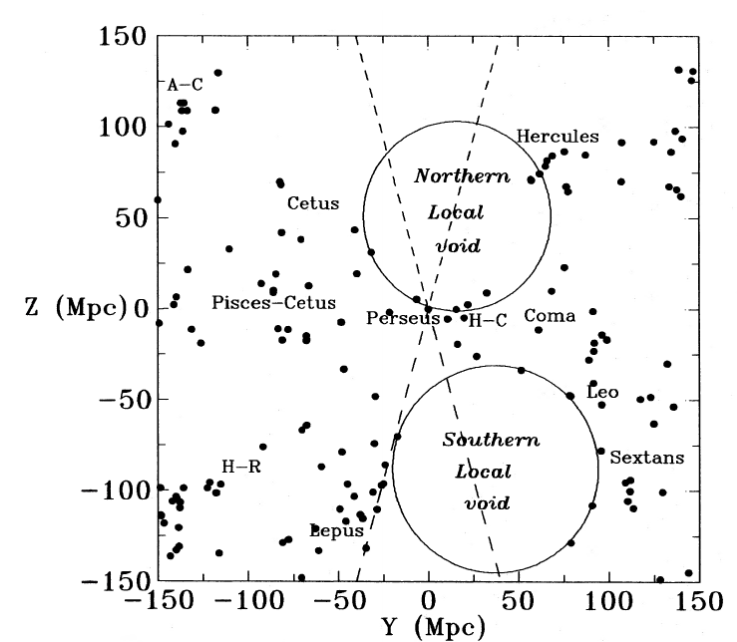
Additional Editor’s Note
The two supervoids are striking because they are nearly identical in size and very symmetrical about the supergalactic plane. Note how the avoidance zone of our galaxy is not enough to explain these huge voids, which extend much further. It would be enough to move the center of supergalactic coordinates, which is conventionally established in the center of our galaxy, so that these two enormous supervoids would correspond very well with the “space deposits” that The Urantia Book mentions. It should also be noted how the article confirms the preference of clusters and superclusters of galaxies for being close to the supergalactic plane.
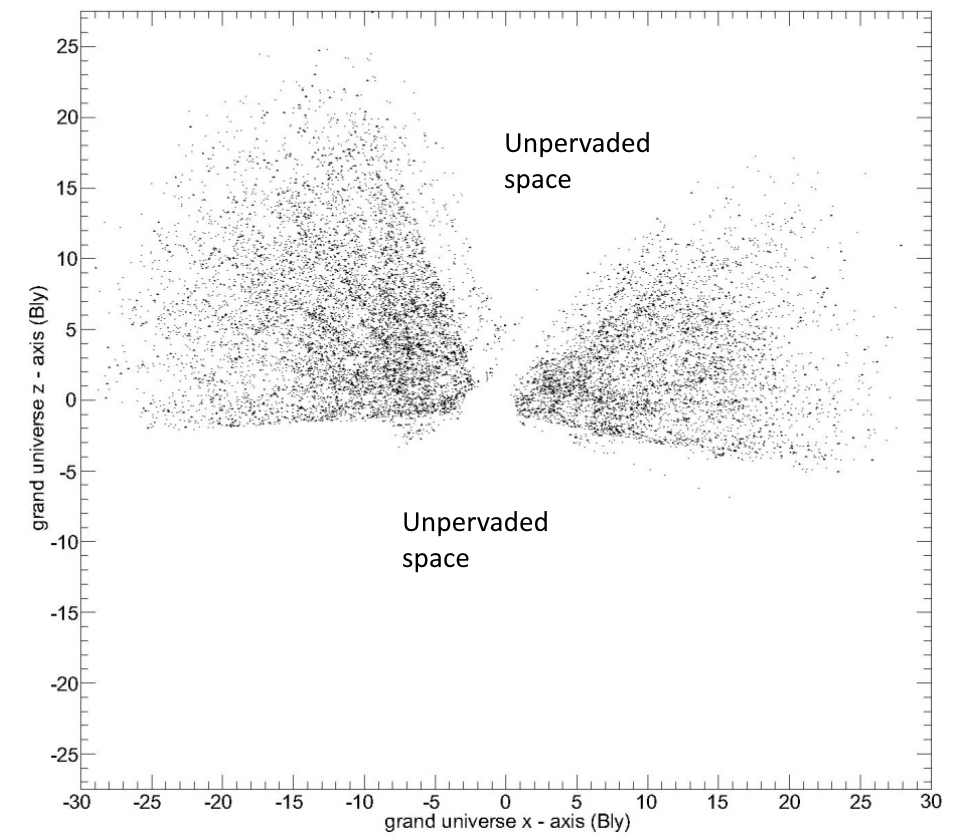
Assuming that such voids are part of even larger regions, I used a Catalog of 132,684 Clusters of Galaxies identified from Sloan Digital Sky Survey III (2013), to verify the claims of The Urantia Book about the “unpervaded space” and its extensions. Plotting 132,684 galaxy clusters in dimensionless points one can actually see what appear to be two huge empty spaces (but not due entirely to the Zone of Avoidance of the Milky Way). Such voids are approximately perpendicular to supergalactic plane. If we cut a slice about 2 billion light years thick, from the center and parallel to the x axis, then you can see the “space reservoir” (unpervaded space) V-shaped in vertical extension (Figure 6).
Still skeptical about the space reservoirs and their extensions, I plotted about 510,000 quasars, using the Half Million Quasars catalog (2015), then I cut a strip parallel to the Z axis. The result was that at an extension of up to 15 billion light years away, the quasar distribution also decreases in the regions of space reservoirs (Figure 7).
Additional Editor’s Note
Quasars are the brightest known objects. They are believed to be the result of black holes at the center of galaxies at immense distances from us. https://en.wikipedia.org/wiki/Quasar
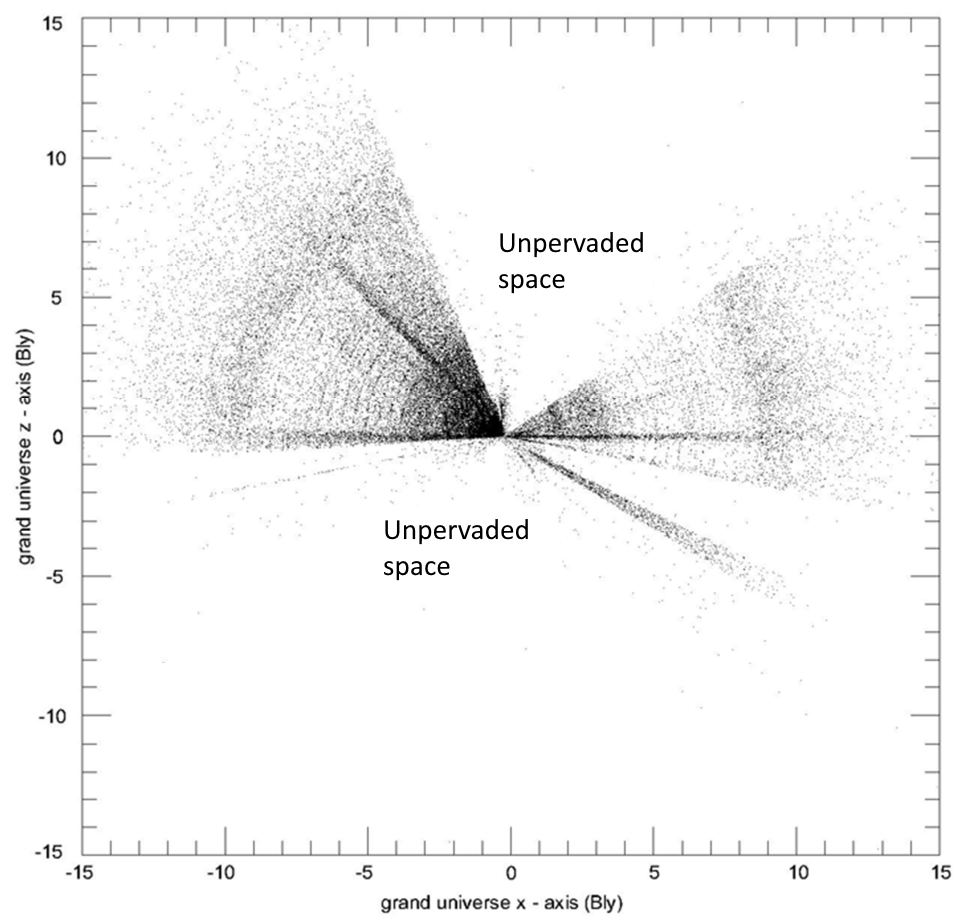
¶ The concept of galaxy filaments and great walls
Consequently, these papers also anticipated the concept of galaxy filaments and great walls of galaxies, which are called by the authors by terms such as “continuous belt” UB 12:1.14, or “tracks of the great space circuits” UB 12:1.2. These enormous structures began to be discovered in the late 1980s, about 30 years after the publication of The Urantia Book.
. . . And the astronomic observers of Uversa think they detect evidence of revolutionary movements in a third outer belt of far-distant space which are beginning to exhibit directional tendencies of a clockwise nature. UB 12:4.15
. . . These tremendous wheels of energizing forces are situated in the first outer space level, a continuous belt of cosmic activity encircling the whole of the known, organized, and inhabited creation. UB 12:1.14
. . . If the master universe were not a series of elliptical space levels of lessened resistance to motion, alternating with zones of relative quiescence, we conceive that some of the cosmic energies would be observed to shoot off on an infinite range, off on a straight-line path into trackless space; but we never find force, energy, or matter thus behaving; ever they whirl, always swinging onward in the tracks of the great space circuits. UB 12:1.2
¶ Brown dwarfs and rogue planets
The Urantia Book anticipated the concept of brown dwarfs and of rogue planets about 7 years before the first person to do it in 1962 [16]. The astronomer Shiv Kumar S. initially called these bodies (still theoretical) of “black dwarfs”. The first object of this kind was discovered only in 1994 [17].
Shiv S. Kumar theorizes in his 1963 article the following:
The numerical results presented here show clearly that, for a given chemical composition, there exists a limiting mass below which a contracting star cannot reach the mainsequence stage because the temperature and density at the center are too low for hydrogen-burning to start. Instead, the star becomes a degenerate star as a consequence of the contraction. After the star has evolved beyond the stage of maximum central temperature, further contraction will take it toward the stage of complete degeneracy. Thus all stars having a mass less than a certain limiting mass ultimately become completely degenerate objects or “black” dwarfs without ever going through the normal stellar evolution. The exact determination of this limiting mass for a given composition requires a knowledge of the luminosity of the contracting stars. This can be obtained if we know the atmospheric structure in addition to the interior models computed here. However, assuming reasonable luminosities for these stars (see the following paper), we find that, for stars with population I composition, the limiting mass is approximately 0.07. Similarly, for the population II stars the limiting mass is approximately 0.09.
Note: The masses in the article are given in solar masses, which is commonly expressed with the symbol .
The papers of 1955 called these spheres by different names, and describing the process of formation of some suns, they claim:
When less than one tenth the size of your sun, these fiery spheres rapidly contract, condense, and cool. . . . UB 41:3.4
Additional Editor’s Note
The coincidence of The Urantia Book in saying less than 0.1 with what Shiv S. Kumar discovered seven years later (0.09), is surprising.
In two other papers they describe that certain spheres are dark and can also be formed by aggregations of matter slowly moving in the space; even mentioning the existence of an exomoon orbiting a 'dark planet’ without a main sun:
Some of the dense dark islands are the direct result of the accretions of transmuting energy in space. Another group of these dark islands have come into being by the accumulation of enormous quantities of cold matter, mere fragments and meteors, circulating through space. Such aggregations of matter have never been hot and, except for density, are in composition very similar to Urantia. UB 15:5.10
The oldest inhabited world of Satania, world number one, is Anova, one of the forty-four satellites revolving around an enormous dark planet but exposed to the differential light of three neighboring suns. Anova is in an advanced stage of progressive civilization. UB 49:0.5
¶ The format of Orvonton, the seventh superuniverse
The superuniverse of Orvonton is composed of mostly the Milky Way, it is the main plane of the superuniverse but not its entirety. The seventh superuniverse, so named by The Urantia Book, covers the entire Milky Way and all around in the shape of an “elongated plane”. The Milky Way is positioned perpendicularly inside this plane.
Practically all of the starry realms visible to the naked eye on Urantia belong to the seventh section of the grand universe, the superuniverse of Orvonton. The vast Milky Way starry system represents the central nucleus of Orvonton, being largely beyond the borders of your local universe.[18] This great aggregation of suns, dark islands of space, double stars, globular clusters, star clouds, spiral[19] and other nebulae, together with myriads of individual planets, forms a watchlike, elongated-circular grouping of about one seventh of the inhabited evolutionary universes[20].
From the astronomical position of Urantia, as you look through the cross section of near-by systems to the great Milky Way, you observe that the spheres of Orvonton are traveling in a vast elongated plane, the breadth being far greater than the thickness and the length far greater than the breadth. UB 15:3.1-2
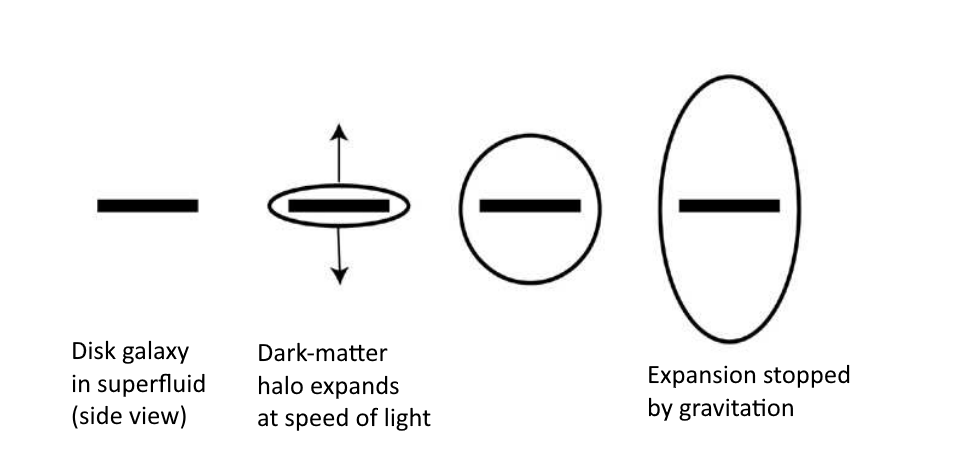
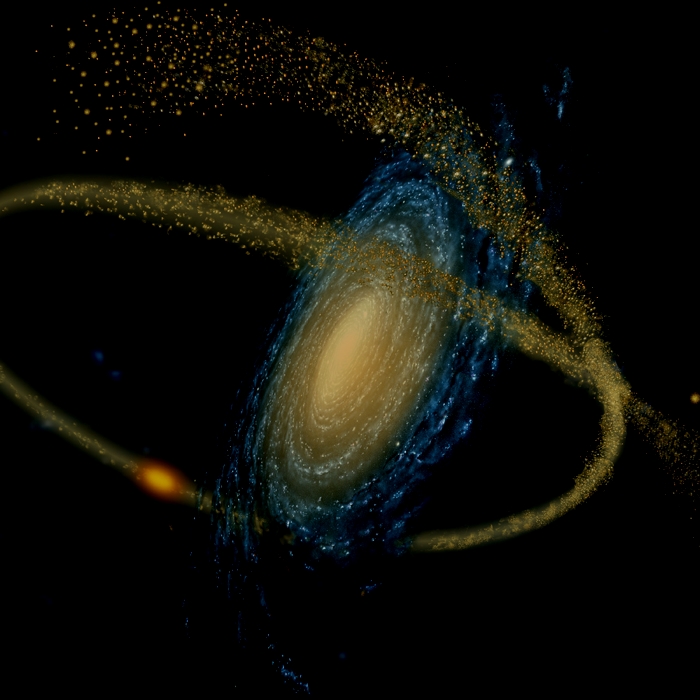
The description of an elongated system of these in which the Milky Way is arranged would be very unusual in 1955 and even in the coming decades. But now studies indicate that a halo of dark matter in the same way is encompassing the entire Milky Way[21]. In the above paragraphs, The Urantia Book makes clear reference to the globular clusters and Sag DEG, but this elliptical galaxy in a loop orbiting the poles of the Milky Way was discovered only in 1994, 39 years after the papers of 1955.
Additional Editor’s Note
The Sagittarius Dwarf Elliptical Galaxy or SagDEG is a satellite galaxy of the Milky Way, with a diameter of ten thousand light years, and which moves in a polar orbit about 50,000 light years from the center of our galaxy. It was discovered in 1994 by Rodrigo Ibata, Mike Irwin and Gerry Gilmore. https://en.wikipedia.org/wiki/Sagittarius_Dwarf_Spheroidal_Galaxy
¶ Double star of SN 1572
The Urantia Book has anticipated by 49 years the human knowledge that the Tycho’s Supernova, whose light reached us in 1572 AD, in fact it was an explosion of a double star (which had never been proposed). The remains of this supernova was only located for sure in 1957. Then, only in 2004 was discovered the companion star (https://en.wikipedia.org/wiki/SN_1572).
This is what The Urantia Book states:
The most recent of the major cosmic eruptions in Orvonton was the extraordinary double star explosion, the light of which reached Urantia in A.D. 1572. This conflagration was so intense that the explosion was clearly visible in broad daylight. UB 41:3.5
This is what was published in Nature magazine in October 2004:
We found a type G0–G2 star, similar to our Sun in surface temperature and luminosity (but lower surface gravity), moving at more than three times the mean velocity of the stars at that distance, which appears to be the surviving companion of the supernova.[22]
¶ Peculiar Velocity
The Urantia Book anticipated by at least in 21 years the scientific knowledge of the “peculiar velocity”. In 1976 it was discovered that some galaxies were not following the expansion of the universe just as Hubble’s Law predicted, but rather they seemed to follow a different movement in an unexpected direction. This became known as Rubin-Ford effect[23]. The papers of 1955 claim that vast regions of galaxies, which in addition to expanding also follow well defined flows and preferred movements in other directions (these are called “secondary movements” UB 12:4.9), the book also explains the reason for these movements.
This alternate zoning of the master universe, in association with the alternate clockwise and counterclockwise flow of the galaxies, is a factor in the stabilization of physical gravity designed to prevent the accentuation of gravity pressure to the point of disruptive and dispersive activities. Such an arrangement exerts antigravity influence and acts as a brake upon otherwise dangerous velocities. UB 11:7.9
But the greatest of all such distortions arises because the vast universes, of outer space, in the realms next to the domains of the seven superuniverses, seem to be revolving in a direction opposite to that of the grand universe. That is, these myriads of nebulae and their accompanying suns and spheres are at the present time revolving clockwise about the central creation. The seven superuniverses revolve about Paradise in a counterclockwise direction. It appears that the second outer universe of galaxies, like the seven superuniverses, revolves counterclockwise about Paradise. And the astronomic observers of Uversa think they detect evidence of revolutionary movements in a third outer belt of far-distant space which are beginning to exhibit directional tendencies of a clockwise nature. UB 12:4.15
Additional Editor’s Note
Today a good number of distortions are being discovered in the measurements that move away from the Hubble Law of universal expansion. For example, there is talk of “redshift space distortions” (Redshift-space distortions or RSDs), whose primary manifestation are the so-called “Fingers of God”, apparent linear megastructures in the distribution of galaxies that are observed when redshift is used as the unit of distance instead of actual distances. A similar effect is the so-called Kaiser effect, in which the distortion is caused by the coherent motions of galaxies as they move toward the center of their clusters.
In fact, the Rubin-Ford effect, which was not very well received when it was first published in 1976, has since been confirmed and there is now talk of a “Large-scale streaming” (Large-scale streaming) in cumulus clouds of galaxies. These are some of the conclusions of modern studies on the matter:
Recent observations of two all-sky samples of galaxies have provided evidence for systematic large-scale deviations from isotropic Hubble flow. The first of these was the preliminary report of our re-investigation of the Rubin et al. (1976) sample of spiral galaxies using infrared techniques (Collins, Joseph & Robertson 1986). The application of infrared Tully-Fisher and optical—infrared colour—magnitude luminosity indicators confirms the ‘Rubin—Ford effect’, i.e. and apparent Local Group motion, relative to this all-sky galaxy sample, which is approximately orthogonal to the velocity inferred from the dipole anisotropy in the 2.7 K cosmic background radiation (CBR). We interpreted this result in terms of a systematic streaming velocity of these galaxies of ~970 km s-1. Sinvce the mean redshift of the sample is 5100 km s-1, this streaming is on a spatial scale of ~100 h-1 Mpc (where the Hubble constant is 100 h km s-1 Mpc-1). A sample of elliptical galaxies of mean redshift 3000 km s-1 observed by Dressler et al. (1987) shows a similar streaming of ~600 km s-1.
In contrast, a study by Aaronson et al. (1986) of the spirals in 10 clusters well outside the Local Supercluster, at redshifts of 4000 to 1000 km s-1, directly contradicts these results. Aaronson et al. find a Local Group motion with respect to these clusters in good agreement, in magnitude and direction, with the Local Group motion relative to the CBR. Thus the Aaronson et al. study indicates that these 10 clusters have no streaming component along this direction.
The confirmation of coherent streaming motions as large as ~700 km s-1 on scales of >60 h-1 Mpc would have profound implications for models of the origin of large-scale structure in the Universe. In particular, the cold dark matter models currently in vogue (cf. Blumenthal et al. 1984) do not produce streaming velocities this large (White et al. 1987). Thus it is of paramount importance to resolve the inconsistencies between these studies. (James, P.A., Joseph, R.D., Collins, C.A., Large-scale streaming of cluster elliptical galaxies, Royal Astronomical Society (1987) 229, 53-59.)
The Urantia Book already predicts many years before these studies that several large-scale movements are taking place in the universe UB 12:4.7. One, which is called “space respiration”, is equivalent, although with lower speeds, to the universal expansion enunciated by Hubble’s Law. The second movement, described as the “alternate directional swings of the successive space levels”, may be the one that is beginning to be detected in these recent studies. Note how the scales at which these unusual streams of galaxies have been detected is ~100 h-1 Mpc. Since the value of h shows the uncertainty in the determination of the Hubble constant this value is sometimes set as a parameter in the range 0.5 < h < 0.75. If we take an intermediate value of 0.6, these currents are appearing at 100 / 0.6 = 166 Mpc or 543 million light years. Taking into account that The Urantia Book indicates that the first belt of outer space together with its quiet zone add up to 75 Mly, this region is clearly beyond, in the second or third belts that the book talks about in UB 12:1.14-15.
¶ Higgs Field
There is subtle and accurate information in The Urantia Book related to particle physics. The Higgs field was first proposed in 1962 by Philip Warren Anderson[24]. With the relativistic model developed in 1964 by three independent groups, one of which included Peter Higgs[25]. Strong evidence for this field was only being discovered in 2013 by the Large Hadron Collider at CERN[26].
However, unlike any existing literature in 1955, the Urantia papers mention subtly but clearly, a form of energy not known at that time and with the same properties of the Higgs Field. One should remember that in the mid-twentieth century the concept of so-called luminiferous aether had long been abandoned. So, there would be no apparent reason for The Urantia Book affirming the existence of such analogous “energy” to surpass ether. After all, something more or less like the hypothetical ether would only be proposed seven years after the publication of the book. The fact that the Higgs Field possesses similarities in some points with postulate ether is also mentioned in the book The Fabric of the Cosmos by physicist Brian Greene.
But after all, how could a book without any known author and also without any scientific basis assert with such certainty the existence of a not even theorized phenomenon, which only was discovered almost 6 decades later? All these 10 topics together would be a lottery jackpot. What the book says is as follows:
There is innate in matter and present in universal space a form of energy not known on Urantia. When this discovery is finally made, then will physicists feel that they have solved, almost at least, the mystery of matter. UB 42:1.3
Primordial-force behavior does give rise to phenomena which are in many ways analogous to your postulated ether. Space is not empty; the spheres of all space whirl and plunge on through a vast ocean of outspread force-energy; neither is the space content of an atom empty. Nevertheless there is no ether. UB 42:5.16
¶ Outer Space Levels, and The Local Velocity Anomaly
The Urantia Book tells us that the whole universe is spinning in successive layers of galaxies moving at different speeds and in opposite directions around the axis universal, the Paradise. Each of these gigantic layers is called the “Outer Space Level” (outside the “Great Ellipse”). “Outer space levels” are regions full of galaxies, which are not easily perceived by empty separations, but by changing movement. Between one level and another there is a quiet zone (absence of movement). A level of space differs from the next level of space for presenting different redshifts each other, as they move in opposite directions. The “outer space levels” are composed of clusters, superclusters and galaxy filaments.
The successive space levels of the master universe constitute the major divisions of pervaded space — total creation, organized and partially inhabited or yet to be organized and inhabited. If the master universe were not a series of elliptical space levels of lessened resistance to motion, alternating with zones of relative quiescence, we conceive that some of the cosmic energies would be observed to shoot off on an infinite range, off on a straight-line path into trackless space; but we never find force, energy, or matter thus behaving; ever they whirl, always swinging onward in the tracks of the great space circuits. UB 12:1.2
The papers state that the first level is a belt of galaxies orbiting the same center as the “Great Ellipse”, but in an opposite direction. In a top view of the Local Sheet plane, the ellipse of galaxies would move clockwise, while the first level of galaxies would move counter-clockwise. The second level of outer space maintains a clockwise rotation. But if it were thus, we would observe a clear difference in the peculiar velocity of these galaxies because on one side they present a greater redshifit, while on the other side we would observe a lesser redshift. There would be a dichotomy redshift. And that’s exactly what we found[27] (Figura 10).
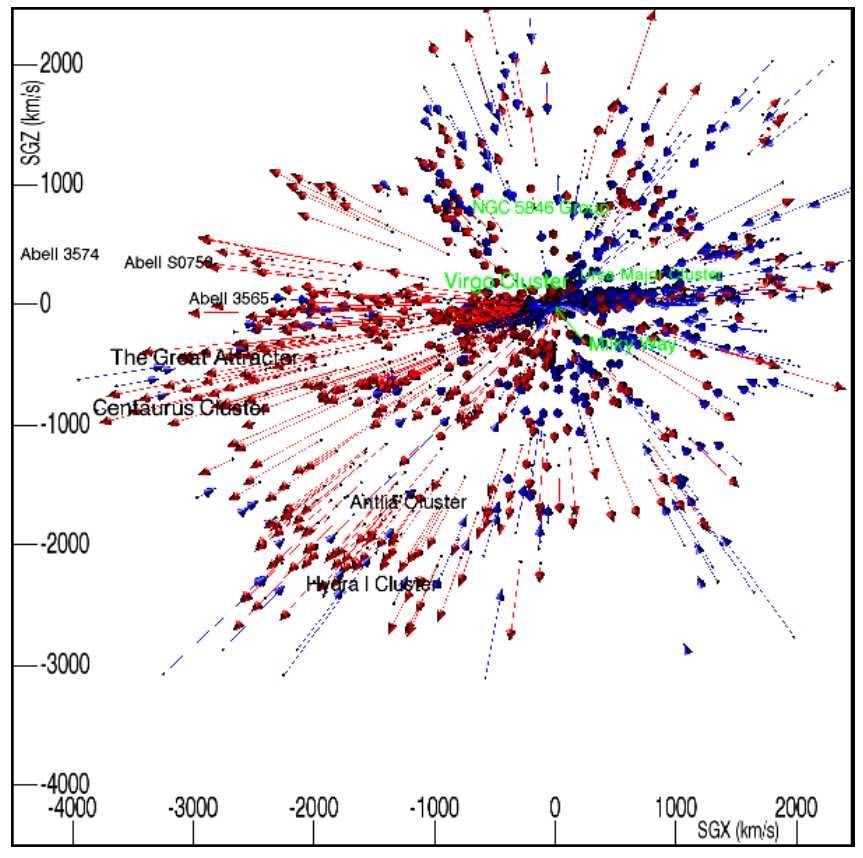
The papers of 1955 do not clearly inform the exact length of 1st level of space, but we can infered from UB 12:1.14-15, which 1st level extends to about 97 Mly beyond the Milky Way, or 75 Mly to outside the ellipse, with a maximum overall diameter of approximately 170 Mly (including the Virgo supercluster). However, the second level of outer space should be much larger. Talking about the first outer space levels the mysterious authors state that detected at least 70,000 aggregations of matter, higher than any of the galaxies of the “Great Ellipse” (UB 31:10.19). For a very rough estimate, if the Milky Way has a mass of about 1,5 1012 , we could assume that the first levels of outer space have about 1,05 1017 .
This is a very near result of the mass of Laniakea Supercluster. Being mere coincidence or not, we should consider the following:
- Laniakea Supercluster and Perseus-Pisces Supercluster form a kind of “bow” inclined around the Local Sheet;
- There is a significant difference of peculiar velocity between Laniakea and Perseus-Pisces;
- The Laniakea center is about 250 Mly, but the Perseus-Pisces center is also 250 Mly.
Therefore, my conjecture is: would Laniakea and Perseus-Pisces components of the same 2nd level of outer space, cited by papers of 1955? If the speculation is correct then the 2nd level space would be really huge, with probably nearly 1 billion light years in diameter. So virtually every point of peculiar velocities that we see in the Figure 10 represent the 2nd level of outer space, which would turn clockwise presenting the galaxies on the left side with radial velocities away, and those on the right, with movement in our direction.
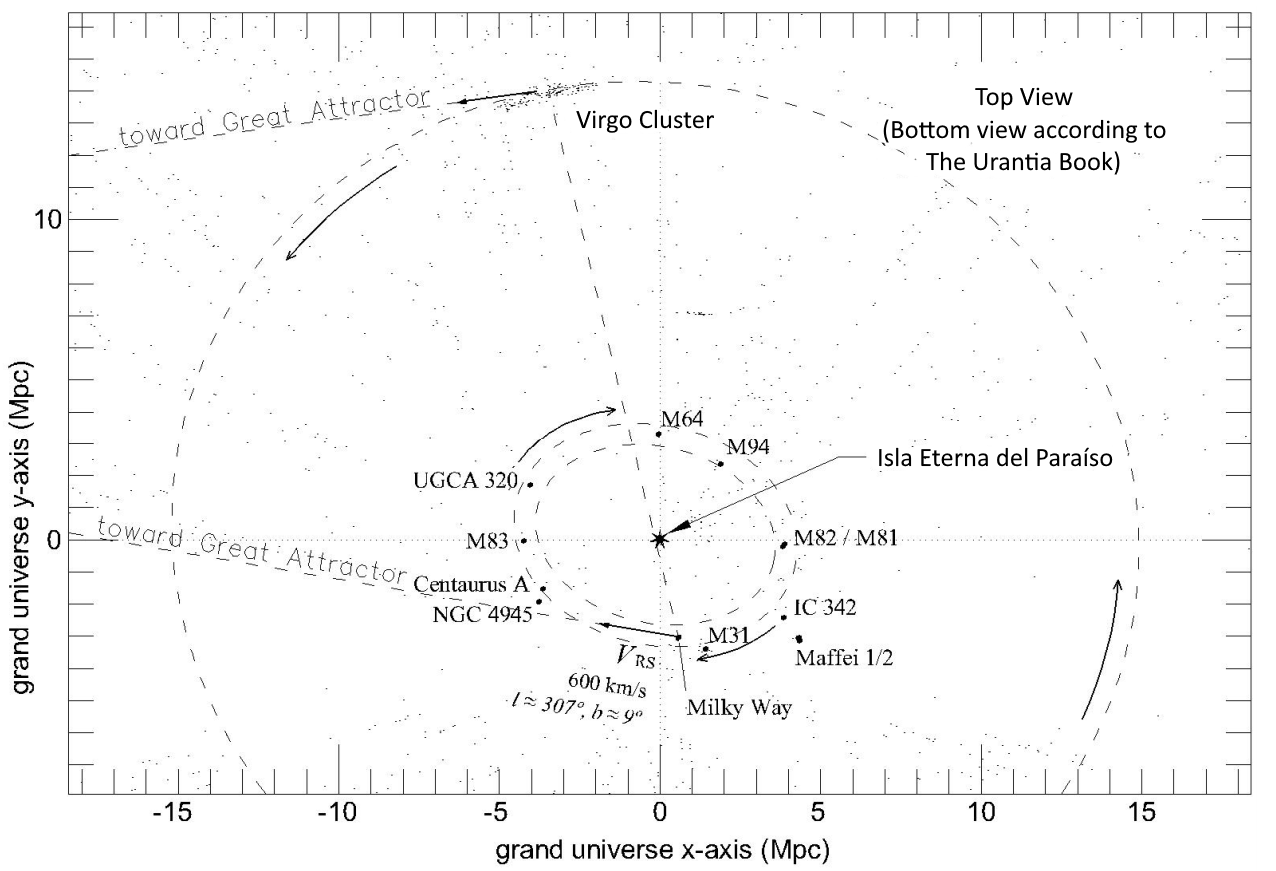
Alternative movements of outer space levels appear to be part of the solution to the riddle of the Great Attractor. For many years we have asked about the cause of the movement towards the Great Attractor, which is over 150 million light years distant and did not appear to have enough mass to justify the attraction. If The Urantia Book is correct, and if I’m interpreting correctly, the movement in this direction should be partially illusory, caused by the tangential velocity of the great orbit that our galaxy makes around the ellipse. The movement of Virgo Cluster and other galaxies towards the Great Attractor would also be apparent, due to contrary movements of the outer space levels (Figure 11).
The Virgo Cluster would be situated on the 1st of Outer Space Level, while the region of the Great Attractor is the 2nd level, both move in opposite directions. This coincides with the fact that the Fornax Cluster region is going in the opposite direction, instead of also appearing to be falling toward the Great Attractor. The agglomerate Fornax would be in the first outer space level, in almost the opposite direction of the Virgo cluster, running therefore, in a contrary direction to the “Great Ellipse”. If we look at an extragalactic map from the top position of supergalactic plane, we perceive soon that the Virgo Cluster, Coma 1 and Ursa Major Cluster form a curved belt around the Local Sheet.
If all of these suppositions are correct, the implications would be disastrous for the standard cosmology. The idea that enormous superclusters and galaxy filaments were orbiting a center no further than 9 million light years away from Earth seems ridiculous, and may be a little more bizarre and inexplicable than the accelerating expansion of the Universe. If these alternative movements of galaxies exist in relation to a common center, how can we explain these movements? What’s the cause of it? Authors who anticipated the discoveries, previously mentioned, also do not know although they have some hypotheses as can be seen on UB 12:4.2-11.
According to the authors there are 4 types of motions of galaxies in space, and the first two are absolute, that is assessed in relation the “Paradise” immobile:
- The motion of space itself (expansion space);
- The alternating swings of the successive space levels (as considered above);
- The relative movement (the attraction of large clusters of galaxies);
- The compensatory or related movement, to coordinate all other movements. UB 12:4.8-11
¶ A consideration about the “Central Universe” and the Great Ellipse
According to The Urantia Book, the Central Island is the “most gigantic organized body of cosmic reality in all the master universe” and “the eternal center of the universe of universes” UB 11:0.1. This nucleus, appropriately called “Paradise” is not limited to space and time. “Paradise exists without time and has no location in space” UB 11:2.10. This stationary Island does not occupy space as it has existence outside it.
The Isle of Paradise — Paradise not otherwise qualified — is the Absolute of the materialgravity control of the First Source and Center. Paradise is motionless, being the only stationary thing in the universe of universes. The Isle of Paradise has a universe location but no position in space. This eternal Isle is the actual source of the physical universes — past, present, and future. UB 0:4.12
Roughly: space seemingly originates just below nether Paradise[28]; time just above upper Paradise. Time, as you understand it, is not a feature of Paradise existence, . . . Paradise is nonspatial; hence its areas are absolute and therefore serviceable in many ways beyond the concept of mortal mind. UB 11:2.11
The center and focal point of absolute material gravity is the Isle of Paradise, complemented by the dark gravity bodies encircling Havona and equilibrated by the upper and nether space reservoirs. All known emanations of nether Paradise invariably and unerringly respond to the central gravity pull operating upon the endless circuits of the elliptical space levels of the master universe. UB 11:8.2
If really the galaxies that compose the great ellipse are orbiting an unbelievable gravity body that is in the exact geographic center of this ellipse (which would be ridiculous to modern cosmology), we could assume at least that:
- The galaxies of the average position of the ellipse and from the “West” (M64 and M94) should have smaller redshifts than those the north edge, because they are orbiting the opposite side of the Milky Way;
- If these galaxies are in an orderly elliptical orbit, they should have a small peculiar velocity, different those from the outside. (Local Velocity Anomaly?);
- For the center of gravity also to be the geographical center of the ellipse, the supermassive stationary object should not have a spherical regular form.

Obviously the latter assumption can not be verified, but there is something interesting about the shape and dimensions of the eternal Isle. According to The Urantia Book, this great body has a geometric shape of a triaxial ellipsoid (Figure 13).
In form Paradise differs from the inhabited space bodies: it is not spherical. It is definitely ellipsoid, being onesixth longer in the north-south diameter than in the east-west diameter. The central Isle is essentially flat, and the distance from the upper surface to the nether surface is one tenth that of the east-west diameter. UB 11:2.2
When we plotted all seven galaxies of the ellipse in a 3d software we observe an interesting configuration: they all seem to behave with swings up and down while they makes its orbit. In this case, how there would be an odd number of galaxies in a oscillatory motion, at a certain point of the ellipse, we would find two galaxies that seem to be “up” or two “down” (fig. 14 e 15). This curious pattern can be observed in the large elipse.[29]
. . . Every known form of cosmic reality has the bend of the ages, the trend of the circle, the swing of the great elipse. UB 11:8.2
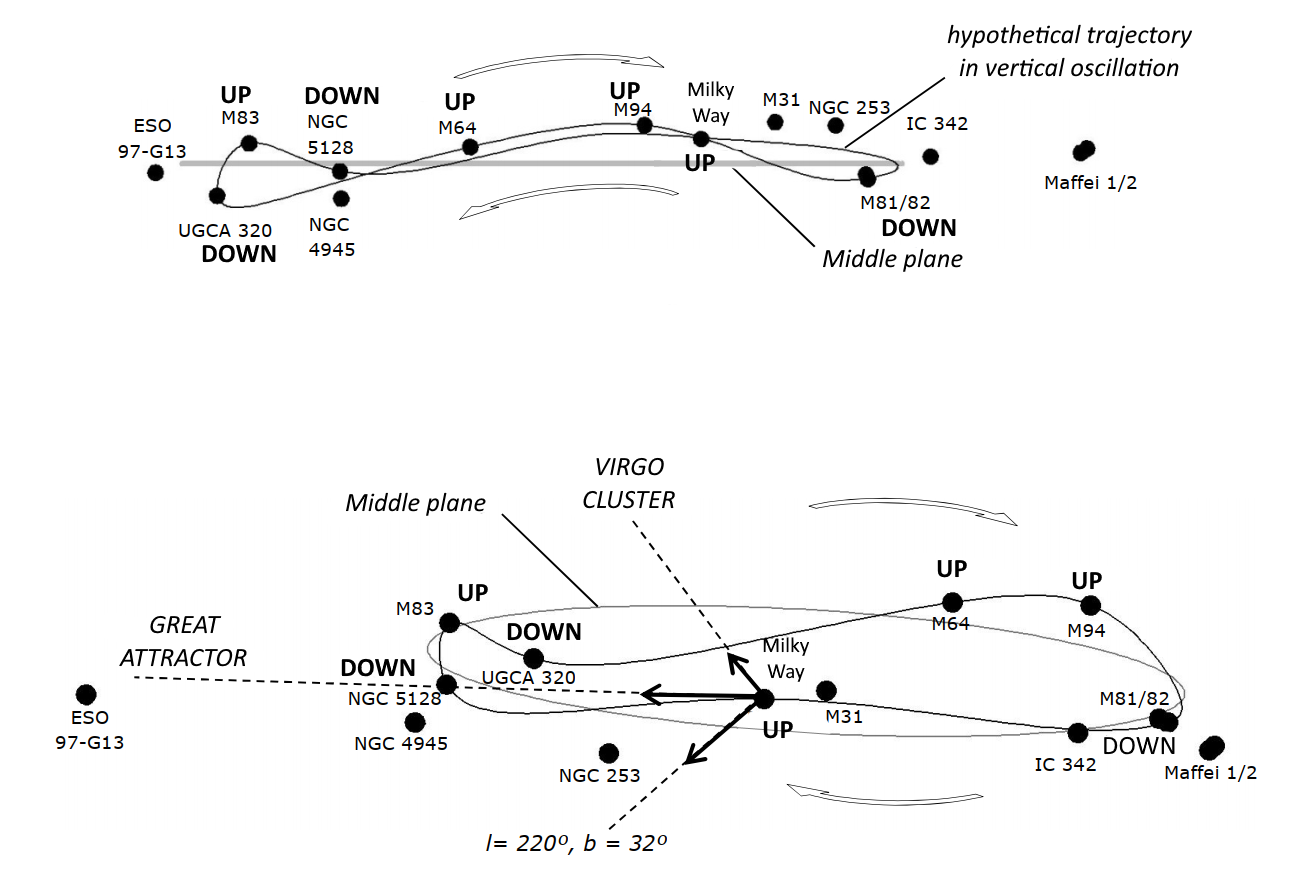
¶ Why is it important?
These papers published in 1955 make reference to about 10 scientific concepts unknown at the time and only discovered a few decades later:
- An elliptical arrangement of galaxies in our neighborhood extragalactic and the seven positions ordered of these galaxies, as indicated by The Urantia Book;
- The existence of independent trajectories of the Milky Way suns;
- Cosmic voids (zones of quiescence and quiet of space);
- North and South Voids (reservoirs);
- The formation of galaxies “belts”;
- The concept of the brown dwarf and rogue planets;
- The fact that the format and dimensions of Orvonton coincide with the format of “dark matter” and other clusters around the Milky Way;
- The explosion of a double star of 1572 A.D.;
- The peculiar motion of galaxies;
- The concept of Higgs field.
Even decades after 1955 some these of concepts did not appear in any literature except those strange papers whose human authorship is unknown. Could this knowledge all be the fruit of some twentieth century genius with a fertile imagination, to the point of anticipating what science had not yet discovered and still prefer to remain anonymous? Could these papers really have originated from non human intelligences? However, if there really existed a human able to predict these facts, why would the people most well trained in that time did not? The most interesting thing is that The Urantia Book is not a scientific book, and certainly not even the main objective of the authors was to present scientific information unknown to mankind, considering, for example, that more than one third of all the content of 2097 pages, is a narrative of the life and teachings of Jesus of Nazareth.
Notwithstanding the existence of errors in this book, (errors which reflected the scientific point of view of the 30s; UB 101:4); the evidences presented here seem to be (in the view of a layman) amazing. Should we stop and consider the chances of someone making each of these suppositions in 1955, and then match. However, I ask the reader to understand: this letter is not a validation trial of an alleged hoax, combined with pseudoscience and all it’s imaginative productions. Rather, this paper arose only by observation of facts already discovered and strangely related to a supposed contact with non-human intelligent entities.
I wrote about some cosmological questions in this letter, but I have in my files about 13 archaeological anticipations made by the same papers. Cosmology and archeology are not my areas, I’m no astronomer shipowner much less a shipowner archaeologist, I am a student of civil engineering. I regret not having qualifications and knowledge necessary to develop a more worthy paper and the height of the importance of this subject. So I request that all these questions are analyzed by professionals and institutions in the area. It might be this book the first evidence that we had contact with extra-planetary or non-human intelligences? Ironically, would the first evidence of extraterrestrial intelligent life has coming, not from the SETI, FAST or other programs, but be all this time on our own shelves?
I hope this letter will be of use in your future work and keenly await your response.
Yours faithfully
The Author
¶ External links
¶ Notes
McCall, Marshall L. A Council of Giants. Monthly Notices of the Royal Astronomical Society (2014): stu199. https://arxiv.org/abs/1403.3667 ↩︎
Urantia: name given to the Earth in book. ↩︎
All “superuniverses” seem to be composed of a giant galaxy, like the Milky Way, and other smaller galaxies around. According to The Urantia Book, we are situated in the seventh superuniverse, which has a radius of 250,000 light years (inhabited part), whose center is the same as the Milky Way (UB 15:3.1-4; UB 15:4.9; UB 32:2.11). ↩︎
According to the author(s): “Paradise is a term inclusive of the personal and the nonpersonal focal Absolutes of all phases of universe reality. […] All share Paradise as the place of origin, function, and destiny, as regards values, meanings, and factual existence”. UB 0:4.11 ↩︎
For better understanding and writing, we will henceforth consider that The Urantia Book was actually composed by several authors, as stated by the book. ↩︎
Van den Bergh, Sidney. A catalogue of dwarf galaxies. Publications of the David Dunlap Observatory 2 (1959):147-150. ↩︎
Tully, R. Brent, et al. Cosmicflows-2: the data. The Astronomical Journal 146.4 (2013): 86 ↩︎
Montet, Benjamin T., et al. Stellar and planetary properties of K2 Campaign 1 candidates and validation of 17 planets, including a planet receiving Earth-like insolation. The Astrophysical Journal 809.1 (2015): 25. ↩︎
With perspicacity, the authors of The Urantia Book avoid from using the term “void” to describe these regions. Today we know that these voids are not completely empty. By adopting terms such as “relatively quiet space zones” or “the midspace zones of quiescence” that define large clusters of galaxies, we can well understand that in these regions the movement of galaxies is less. So one of the reasons for the lack of peculiar movement in these regions is precisely the lowest concentration of galaxies. ↩︎
However, not all cosmic voids is a defined limit of space level, but certainly each level space is limited by voids. ↩︎
De Vaucouleurs, G. “Nearby groups of galaxies.” Galaxies and the Universe 1 (1975): 557. http://ned.ipac.caltech.edu/level5/Dev2/frames.html ↩︎
Einasto, J., Corwin, H.G., Huchra, J., Miller, R.H., Tarenghi, M. 1983, Highlights of Astronomy, Vol. 6, ed. R. West, Reidel, Dordrecht, p. 757 ↩︎
Einasto, Maret, et al. “The structure of the universe traced by rich clusters of galaxies.” Monthly Notices of the Royal Astronomical Society 269.2 (1994): 301-322. ↩︎
I suppose that these empty and its adjacent regions are likely to represent the beginning of these reservoirs, but not all of it. ↩︎
Kumar, Shiv S. The Structure of Stars of Very Low Mass. The Astrophysical Journal 137 (1963): 1121 ↩︎
Rebolo, R., MR Zapatero Osorio, and E. L. Martin. Discovery of a brown dwarf in the Pleiades star cluster. (1995): 129-131 ↩︎
In the mid of the fifties, Gérard de Vaucouleurs identified the Large Magellanic Cloud as a Magellanic spiral galaxy. ↩︎
Schive, Hsi-Yu, et al. “Understanding the core-halo relation of quantum wave dark matter from 3d simulations.” Physical review letters 113.26 (2014): 261302. ↩︎
Ruiz-Lapuente, Pilar, et al. “The binary progenitor of Tycho Brahe’s 1572 supernova.” Nature 431.7012 (2004): 1069-1072. ↩︎
Rubin, Vera C., et al. “Motion of the Galaxy and the local group determined from the velocity anisotropy of distant SC I galaxies. I-The data.” The Astronomical Journal 81 (1976): 687-718. ↩︎
Anderson, Philip W. “Plasmons, gauge invariance, and mass.” Physical Review 130.1 (1963): 439. ↩︎
Higgs, Peter W. “Broken symmetries and the masses of gauge bosons.” Physical Review Letters 13.16 (1964): 508 ↩︎
Englert, François, and Peter W. Higgs. “The Nobel Prize in Physics 2013.” foton 3.2 (2013): 1. ↩︎
Tully, R. Brent, Yehuda Hoffman, and Denis Courtois. “Cosmography of the local universe.” The Astronomical Journal 146.3 (2013): 69. ↩︎
According to the authors the space is being originated soon “below” Paradise. This is the region that contains the Local Void. Astronomers believe that the empty site is growing and “away” galaxies out. To see: Tully, R. Brent, et al. “Our peculiar motion away from the local void.” The Astrophysical Journal 676.1 (2008): 184. ↩︎
Similar movements of vertical oscillations were investigated in barred galaxies: Skokos, Ch, P. A. Patsis, and E. Athanassoula. “Orbital dynamics of three-dimensional bars–I. The backbone of three-dimensional bars. A fiducial case.” Monthly Notices of the Royal Astronomical Society 333.4 (2002): 847-860. ↩︎